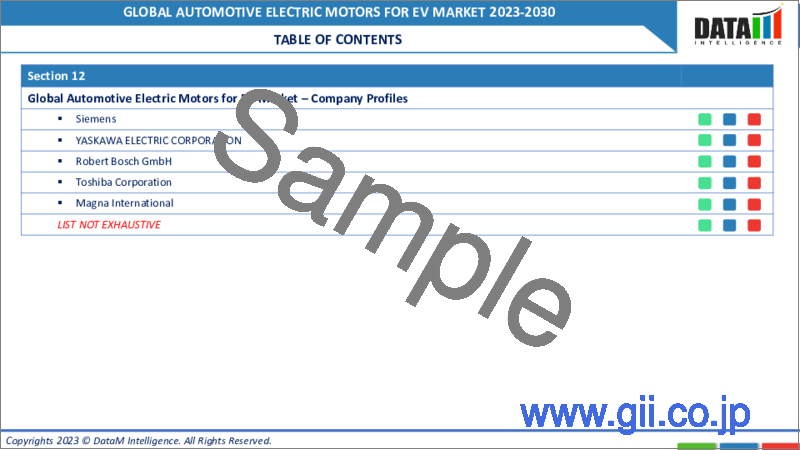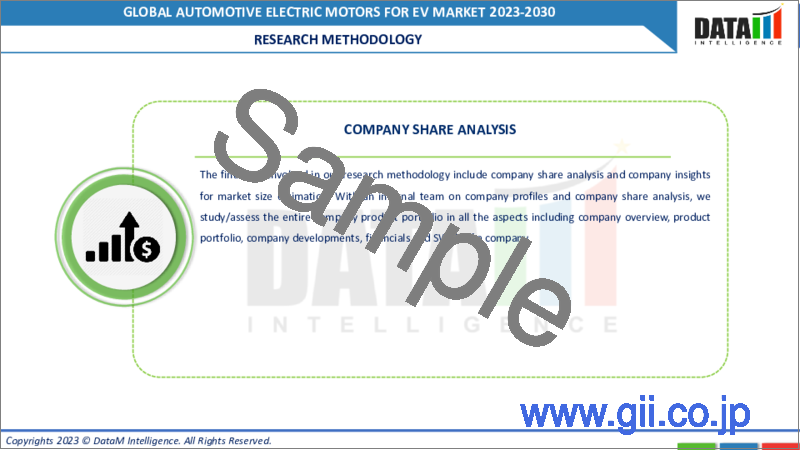|
|
市場調査レポート
商品コード
1272761
EV用電気モーターの世界市場-2023-2030Global Automotive Electric Motors for EV Market - 2023-2030 |
||||||
|
● お客様のご希望に応じて、既存データの加工や未掲載情報(例:国別セグメント)の追加などの対応が可能です。 詳細はお問い合わせください。 |
|||||||
| EV用電気モーターの世界市場-2023-2030 |
|
出版日: 2023年05月15日
発行: DataM Intelligence
ページ情報: 英文 205 Pages
納期: 約2営業日
|
- 全表示
- 概要
- 目次
市場概要
EV用電気モーターの世界市場は、2022年に666億2,990万米ドルに達し、2030年に7,914億4,320万米ドルに達すると予測されます。同市場は予測期間中(2023年~2030年)に31.5%のCAGRを示すと予想されています。
ホンダ、ゼネラルモーターズ、テスラ、フォードなどの大手自動車会社による電気自動車への大規模な投資は、近い将来、電気モーター市場の成長を促進すると予想されます。さらに、モーターメーカーと自動車会社間のパートナーシップの発展が、市場を世界的に拡大すると予想されます。
2022年には、世界のEV用電気モーター企業上位5社が総市場の62.08%を占め、上位3社は総市場の42.77%近くをより多く占めています。
また、メーカーは、AC同期モータとブラシ付き電流励磁の統合など、ユニットの効率的な生産が求められており、電気自動車用モータの需要を高めています。
自動車メーカーとモーターメーカーとの間で多くの合併や契約が行われています。急速充電、コネクテッドビークル、車載バッテリー技術など、洗練されたカーシステムの採用を加速させる。
市場力学
エネルギー分野からの需要増加
アジア太平洋地域、特に中国とインドが電力需要の増加の大半を占めると予測されています。所得と生活水準の向上により、インドは現在、世界第3位のエネルギー消費国となっています。
さらに、自動車の排ガスに関する政府の厳しい規則や規制は、電気自動車が危険なガスを放出することが少ないため、世界的に市場の成長を促進します。そのため、電気自動車の生産に使用される電気モーターの需要が増加します。
例えば、ノルウェーは、莫大な購入補助金やその他のインセンティブにより、世界の電気自動車の首都となりました。同国では、EVは取得税と25%の付加価値税が免除されます。
また、高速道路の通行料免除、フェリーの無料乗船、特定の都市での無料駐車など、優遇措置も受けられます。昨年の新規登録台数のうち、純粋な電気自動車が占める割合は20%を超えています。
EV用電気モーターの高価格化
EV用電気モーターの高価格は、市場成長の大きな障害となっています。その原因として、電池に使用される原材料と、電池の製造に関わるコストのかかるプロセスが重要な役割を担っています。バッテリーシステムのコストは、バッテリー容量が20kWの中型車では1kWhあたり約500ユーロ、合計10,000ユーロになります。
エネルギー密度を高めた新しい電池材料や製造技術の改善により、2020年までにコストを大幅に削減できる可能性があります。1kWhあたりの推定コストは100~250ユーロです。
製品の価格設定は、どの事業者が電気モーター市場を独占するのかを決定します。原材料の価格に変化があれば、モーターの価格にもすぐに影響が出ます。その結果、出てきた価格変動は、市場の他のメーカー/サプライヤーが共有する必要があります。
COVID-19影響度分析
COVID-19分析では、COVID前シナリオ、COVIDシナリオ、COVID後シナリオに加え、価格ダイナミクス(COVID前シナリオと比較したパンデミック中・後の価格変動を含む)、需要-供給スペクトラム(取引制限、ロックダウンおよびその後の問題による需要と供給のシフト)、政府の取り組み(政府機関による市場、分野、産業の活性化に関する取り組み)、メーカーの戦略的取り組み(メーカーはCOVID問題を軽減するために何をしたのかをここでカバー)。
目次
第1章 調査手法とスコープ
- 調査手法
- 調査目的および調査範囲
第2章 定義と概要
第3章 エグゼクティブサマリー
- 車種別スニペット
- モーター別
- アプリケーション別
- 地域別スニペット
第4章 市場力学
- インパクトファクター
- 促進要因
- エネルギー分野での需要拡大
- 抑制要因
- EV用電気モーターの価格高騰
- 機会
- 高度なロボット技術の開発により、EV車の需要が高まる
- 影響度分析
- 促進要因
第5章 産業分析
- ポーターのファイブフォース分析
- サプライチェーン分析
- 価格分析
- 法規制の分析
第6章 COVID-19の分析
- COVID-19の分析
- COVID-19登場前シナリオ
- 現在のCOVID-19シナリオ
- COVID-19後または将来のシナリオ
- COVID-19の中での価格・ダイナミクス
- 需給スペクトル
- パンデミック時の市場に関連する政府の取り組み
- メーカーの戦略的な取り組み
- サマリー
第7章 車両タイプ別
- ピュアEV(PEV)
- ハイブリッド車(HEV)
- プラグインハイブリッド車(PHEV)
第8章 モーター別
- ACモーター
- DCモーター
第9章 アプリケーション別
- 乗用車
- 商用車
第10章 地域別
- 北米
- 米国
- カナダ
- メキシコ
- 欧州
- ドイツ
- 英国
- フランス
- イタリア
- ロシア
- その他欧州
- 南米
- ブラジル
- アルゼンチン
- その他南米地域
- アジア太平洋地域
- 中国
- インド
- 日本
- オーストラリア
- その他アジア太平洋地域
- 中東・アフリカ地域
第11章 競合情勢
- 競合シナリオ
- 市況ポジショニング/シェア分析
- M&A(合併・買収)分析
第12章 企業プロファイル
- Siemens Ag Company
- 会社概要
- 製品ポートフォリオと説明
- 財務概要
- 主な発展状況
- Yasakawa Electric
- Robert Bosch GmbH
- Toshiba Corporation
- Magna International
- Denso Corporation
- Mitsubishi Electric Corporation
- Emerson Electric Co
- Abb Motors And Mechanical Inc
- Hitachi, Ltd
第13章 付録
Market Overview
The global automotive electric motors for EV market reached US$ 66,629.9 million in 2022 and is projected to witness lucrative growth by reaching up to US$ 791,443.2 million by 2030. The market is expected to exhibit a CAGR of 31.5% during the forecast period (2023-2030).
Massive investments in electric vehicles by major automotive companies, such as Honda, General Motors, Tesla, and Ford are expected to drive the electric motors market growth in the near future. Moreover, the evolving partnerships between motor manufacturers and automotive companies are expected to expand the studied market globally.
The top five global automotive electric motors for EV companies hold 62.08% of the total market in 2022, whereas the top three players account for more nearly 42.77% of the total market.
Manufacturers are also required to produce efficient production of units to improve their efficiency, such as the integration of AC synchronous motors with brushed current excitation, which raises demand for electric vehicle motors.
Many mergers and agreements have taken place between automotive firms and motor manufacturers. It accelerates the adoption of sophisticated car systems such as quick charging, connected vehicle and vehicle battery technology.
Market Dynamics
Rising Demand from the Energy Sector
The Asia-Pacific region, particularly China and India, is predicted to account for the majority of the rise in electricity demand. Due to the rising income and living standards, India is now the world's third-largest energy consumer.
Moreover, severe government rules and regulations governing vehicular emissions will enhance the market growth globally, as electric vehicles release fewer dangerous gases. This will increase the demand for electric motors used in the production of electric vehicles.
Norway, for instance, has become the world's EV capital as a result of huge purchasing subsidies and other incentives. EVs are exempt from both the acquisition tax and the 25% value-added tax in the country.
They also receive preferential highway treatment, such as toll exemptions, free ferry rides and free parking in select cities. Last year, pure electric vehicles accounted for more than 20% of new registrations.
The high price of automotive electric motors for EV
The high price associated with automotive electric motors for EV acts as a major hurdle for the market growth. The raw materials utilized in the battery, as well as the costly processes involved in battery production, are important causes for this. The battery system costs around 500 euros per kWh for a mid-size vehicle with a battery capacity of 20kW, totaling 10,000 euros.
New battery materials with increased energy density as well as improved manufacturing techniques may result in considerably reduced costs by 2020. The estimated cost per kWh ranges from 100 to 250 euros.
The pricing of the product decides which providers dominate the electric motor market. Any changes in the price of raw materials will have an immediate impact on motor prices. As a result, the price changes that emerge must be shared by the market's other manufacturers/suppliers.
COVID-19 Impact Analysis
The COVID-19 analysis includes Pre-COVID Scenario, COVID Scenario and Post-COVID Scenario along with pricing dynamics (including pricing change during and post-pandemic comparing it with pre-COVID scenarios), demand-supply spectrum (shift in demand and supply owing to trading restrictions, lockdown and subsequent issues), government initiatives (initiatives to revive market, sector or industry by government bodies) and manufacturers strategic initiatives (what manufacturers did to mitigate the COVID issues will be covered here).
Segment Analysis
The global automotive electric motors for EV market is segmented based on vehicle type, motor, application and region.
The growing trend toward sustainable alternative
Plug-in hybrid electric vehicles (PHEV) segment hold the second position in terms of share. A plug-in hybrid electric vehicle, also known as a PHEV, is a form of hybrid electric vehicle that combines a gasoline or diesel engine with an electric drive and a sizable battery that can be refilled by plugging into an electrical outlet or an electric vehicle charging point. Conventional hybrid vehicles have an engine and battery that are powered entirely by fuel or diesel.
The gasoline and financial efficiency of hybrid versions is combined with the all-electric prowess of battery- or fuel-cell-powered cars in plug-in hybrids. Some PHEVs have an electric-only range of more than 70 miles and can store enough energy during normal driving circumstances to reduce their need for gasoline. Compared to normal cars, PHEVs use between 30 and 60 percent less gasoline, which could result in hundreds of dollars in savings for the owner.
Geographical Analysis
Asia-Pacific's growing investments in the adoption of EVs and the presence of key players in the region
Governments across the Asia-Pacific are offering tax incentives and subsidies to encourage the adoption of electric vehicles. Governments in Asia display varying degrees of commitment to electrification. Comprehensive policy frameworks have been built to facilitate electric vehicle adoption in China, Japan and South Korea. Thailand has established the 2030 EV Production Strategy, which seeks to reach 30% of local vehicle production by 2030.
By 2040 and 2050, respectively, Indonesia will have outlawed the sales of any motorbikes powered by fossil fuels. Companies like Toyota, Nissan and Mitsubishi Motors are leading the way in Japan in the quick development of electric cars (EVs). Instead of a gasoline engine, an EV is propelled by a motor and a battery. The motor is made by many manufacturers in various configurations. Nissan has already started selling Leading, Environmentally Friendly, Affordable, Family Car (LEAF) electric cars. Euler Motors also sells Electric Cardo Three Wheelers, which are powered by three-phase induction motors, a form of AC motor.
According to data provided by the China Association of Automobile Manufacturers (CAAM), the production and sales of new energy vehicles (NEVs) in China reached 1.242 and 1.206 million units, respectively, in 2019 and 1.366 and 1.367 million units, respectively, in 2020.
Competitive Landscape
The major global players in the market include Siemens Ag Company, Yasakawa Electric, Robert Bosch GmbH, Toshiba Corporation, Magna International, Denso Corporation, Mitsubishi Electric Corporation, Emerson Electric Co, Abb Motors And Mechanical Inc, and Hitachi, Ltd.
Why Purchase the Report?
- To visualize the global automotive electric motors for EV market segmentation based on vehicle type, motor, application and region, as well as understand key commercial assets and players.
- Identify commercial opportunities by analyzing trends and co-development.
- Excel data sheet with numerous data points of automotive electric motors for EV market-level with all segments.
- PDF report consists of a comprehensive analysis after exhaustive qualitative interviews and an in-depth study.
- Product mapping is available in Excel consisting of key products of all the major players.
The global automotive electric motors for EV market report would provide approximately 65 tables, 55 figures and 205 Pages.
Target Audience 2023
- Manufacturers/ Buyers
- Industry Investors/Investment Bankers
- Research Professionals
- Emerging Companies
Table of Contents
1. Methodology and Scope
- 1.1. Research Methodology
- 1.2. Research Objective and Scope of the Report
2. Definition and Overview
3. Executive Summary
- 3.1. Snippet by Vehicle Type
- 3.2. Snippet by Motor
- 3.3. Snippet by Application
- 3.4. Snippet by Region
4. Dynamics
- 4.1. Impacting Factors
- 4.1.1. Drivers
- 4.1.1.1. Rising Demand from the Energy Sector
- 4.1.2. Restraints
- 4.1.2.1. The high price of automotive electric motors for EV
- 4.1.3. Opportunity
- 4.1.3.1. Developing advanced robotics technology will enhance demand for EV vehicles
- 4.1.4. Impact Analysis
- 4.1.1. Drivers
5. Industry Analysis
- 5.1. Porter's Five Forces Analysis
- 5.2. Supply Chain Analysis
- 5.3. Pricing Analysis
- 5.4. Regulatory Analysis
6. COVID-19 Analysis
- 6.1. Analysis of COVID-19
- 6.1.1. Before COVID-19 Scenario
- 6.1.2. Present COVID-19 Scenario
- 6.1.3. Post COVID-19 or Future Scenario
- 6.2. Pricing Dynamics Amid COVID-19
- 6.3. Demand-Supply Spectrum
- 6.4. Government Initiatives Related to the Market During Pandemic
- 6.5. Manufacturers Strategic Initiatives
- 6.6. Conclusion
7. By Vehicle Type
- 7.1. Introduction
- 7.1.1. Market Size Analysis and Y-o-Y Growth Analysis (%), By Vehicle Type
- 7.1.2. Market Attractiveness Index, By Vehicle Type
- 7.2. Pure Electric Vehicles (PEV) *
- 7.2.1. Introduction
- 7.2.2. Market Size Analysis and Y-o-Y Growth Analysis (%)
- 7.3. Hybrid Electric Vehicles (HEV)
- 7.4. Plug-In Hybrid Electric Vehicles (PHEV)
8. By Motor
- 8.1. Introduction
- 8.1.1. Market Size Analysis and Y-o-Y Growth Analysis (%), By Motor
- 8.1.2. Market Attractiveness Index, By Motor
- 8.2. AC Motor *
- 8.2.1. Introduction
- 8.2.2. Market Size Analysis and Y-o-Y Growth Analysis (%)
- 8.3. DC Motor
9. By Application
- 9.1. Introduction
- 9.1.1. Market Size Analysis and Y-o-Y Growth Analysis (%), By Application
- 9.1.2. Market Attractiveness Index, By Application
- 9.2. Passenger Vehicles *
- 9.2.1. Introduction
- 9.2.2. Market Size Analysis and Y-o-Y Growth Analysis (%)
- 9.3. Commercial Vehicles
10. By Region
- 10.1. Introduction
- 10.1.1. Market Size Analysis and Y-o-Y Growth Analysis (%), By Region
- 10.1.2. Market Attractiveness Index, By Region
- 10.2. North America
- 10.2.1. Introduction
- 10.2.2. Key Region-Specific Dynamics
- 10.2.3. Market Size Analysis and Y-o-Y Growth Analysis (%), By Vehicle Type
- 10.2.4. Market Size Analysis and Y-o-Y Growth Analysis (%), By Motor
- 10.2.5. Market Size Analysis and Y-o-Y Growth Analysis (%), By Application
- 10.2.6. Market Size Analysis and Y-o-Y Growth Analysis (%), By Country
- 10.2.6.1. The U.S.
- 10.2.6.2. Canada
- 10.2.6.3. Mexico
- 10.3. Europe
- 10.3.1. Introduction
- 10.3.2. Key Region-Specific Dynamics
- 10.3.3. Market Size Analysis and Y-o-Y Growth Analysis (%), By Vehicle Type
- 10.3.4. Market Size Analysis and Y-o-Y Growth Analysis (%), By Motor
- 10.3.5. Market Size Analysis and Y-o-Y Growth Analysis (%), By Application
- 10.3.6. Market Size Analysis and Y-o-Y Growth Analysis (%), By Country
- 10.3.6.1. Germany
- 10.3.6.2. The U.K.
- 10.3.6.3. France
- 10.3.6.4. Italy
- 10.3.6.5. Russia
- 10.3.6.6. Rest of Europe
- 10.4. South America
- 10.4.1. Introduction
- 10.4.2. Key Region-Specific Dynamics
- 10.4.3. Market Size Analysis and Y-o-Y Growth Analysis (%), By Vehicle Type
- 10.4.4. Market Size Analysis and Y-o-Y Growth Analysis (%), By Motor
- 10.4.5. Market Size Analysis and Y-o-Y Growth Analysis (%), By Application
- 10.4.6. Market Size Analysis and Y-o-Y Growth Analysis (%), By Country
- 10.4.6.1. Brazil
- 10.4.6.2. Argentina
- 10.4.6.3. Rest of South America
- 10.5. Asia-Pacific
- 10.5.1. Introduction
- 10.5.2. Key Region-Specific Dynamics
- 10.5.3. Market Size Analysis and Y-o-Y Growth Analysis (%), By Vehicle Type
- 10.5.4. Market Size Analysis and Y-o-Y Growth Analysis (%), By Motor
- 10.5.5. Market Size Analysis and Y-o-Y Growth Analysis (%), By Application
- 10.5.6. Market Size Analysis and Y-o-Y Growth Analysis (%), By Country
- 10.5.6.1. China
- 10.5.6.2. India
- 10.5.6.3. Japan
- 10.5.6.4. Australia
- 10.5.6.5. Rest of Asia-Pacific
- 10.6. Middle East and Africa
- 10.6.1. Introduction
- 10.6.2. Key Region-Specific Dynamics
- 10.6.3. Market Size Analysis and Y-o-Y Growth Analysis (%), By Vehicle Type
- 10.6.4. Market Size Analysis and Y-o-Y Growth Analysis (%), By Motor
- 10.6.5. Market Size Analysis and Y-o-Y Growth Analysis (%), By Application
11. Competitive Landscape
- 11.1. Competitive Scenario
- 11.2. Market Positioning/Share Analysis
- 11.3. Mergers and Acquisitions Analysis
12. Company Profiles
- 12.1. Siemens Ag Company*
- 12.1.1. Company Overview
- 12.1.2. Product Portfolio and Description
- 12.1.3. Financial Overview
- 12.1.4. Key Developments
- 12.2. Yasakawa Electric
- 12.3. Robert Bosch GmbH
- 12.4. Toshiba Corporation
- 12.5. Magna International
- 12.6. Denso Corporation
- 12.7. Mitsubishi Electric Corporation
- 12.8. Emerson Electric Co
- 12.9. Abb Motors And Mechanical Inc
- 12.10. Hitachi, Ltd
LIST NOT EXHAUSTIVE
13. Appendix
- 13.1. About Us and Services
- 13.2. Contact Us




